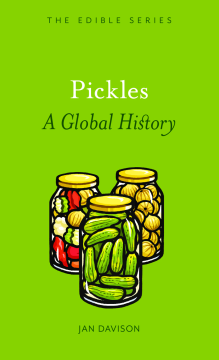
Additional Information
Book Details
Abstract
From the fiery kimchi of Korea to American dill spears; from the spicy achar of India to the ceviche of Latin America; from Europe’s sauerkraut to brined herrings and chutneys, pickles are unquestionably a global food. They are also of the moment. Growing interest in naturally fermented vegetables—pickles by another name—means that today, in the early twenty-first century, we are seeing a renaissance in the making and consumption of pickles. Across continents and throughout history, humans have relied upon pickling to preserve foods and add to their flavor. Both a cherished food of the elite and a staple of the masses, pickles have also acquired new significance in our health-conscious times: traditionally fermented pickles are probiotic and said to possess anti-aging and anti-cancer properties, while pickle juice is believed to prevent muscle cramps in athletes and reduce sugar spikes in diabetics. Nota bene: It also cures hangovers.
In Pickles, Jan Davison explores the cultural and gastronomic importance of pickles from the earliest civilizations’ brine-makers to twenty-first-century dilettantes of dill. Join Davison and discover the art of pickling as mastered by the ancient Chinese; find out why Korean astronaut Yi So-yeon took pickled cabbage into space in 2008; learn how the Japanese pickle the deadly puffer fish; and uncover the pickling provenance of that most popular of condiments, tomato ketchup. A compulsively consumable, globe-trotting tour sure to make you pucker, Davison’s book shows us how pickles have been omnipresent in humanity’s common quest not only to preserve foods, but to create them—with relish.
"Who doesn't love a pickle? Low in calories and packed with flavour, they simply make any meal yummier. A book to relish, this tiny tome chronicles the global rise of the humble pickle, which fuelled workers who built China's Great Wall, flew to space (with a Korean who brought kimchi along for the rocket ride) and is now touted as a cure-all for hangovers."
— Quarterly Review of Biology
"Who doesn't love a pickle? Low in calories and packed with flavor, they simply make any meal yummier. A book to relish, this tiny tome chronicles the global rise of the humble pickle, which fueled workers who built China’s Great Wall, flew to space (with a Korean who brought kimchi along for the rocket ride), and is now touted as a cure-all for hangovers."
— Globe and Mail
“Pickles aren’t simple, or so one learns after consuming just a few pages of Pickles. . . . There are quick pickles, pickle pickles and fermented pickles, not to mention dry salting and dry pickling with soybean paste or rice mold, ketchup, hot sauce—you get the idea. The fundamentals are simple: When the pH drops below 4.6, the acidic environment ‘prevents the growth of food-spoiling microorganisms and eliminates certain food toxins and pathogens.’ In other words, pickling preserves. And as with most cured foods, the results taste great, too. Pickles were common 4,000 years ago in Mesopotamia. Romans pickled whole fried fish in hot vinegar. The range of pickled foods extends from mushrooms in Russia, locusts in Persia and herring in Holland to bananas in the West Indies, lemons in North Africa and feta in Greece. In Japan, they quick-pickle chrysanthemums as a condiment. Who knew?”
— Christopher Kimball, Christopher Kimball's Milk Street Magazine
"A perfectly pocket-sized pickle primer covering everything sour, from German sauerkraut to kosher dills to Latin American ceviche."
— CJ Lotz, Garden & Gun
"Well researched, nicely illustrated, and embracing."
— Petits Propos Culinaires
Jan Davison lives and works in London. She is the author of English Sausages.
Table of Contents
| Section Title | Page | Action | Price |
|---|---|---|---|
| Cover | Cover | ||
| Title Page | 3 | ||
| Imprint Page | 4 | ||
| Contents | 5 | ||
| Introduction | 7 | ||
| 1: Pickling: Principles and Practice | 10 | ||
| 2: Asia: Ferment and Fire | 19 | ||
| 3: The Mediterranean: Ancient and Modern | 40 | ||
| 4: From the Middle East to Latin America: Arabs and Conquistadores | 59 | ||
| 5: From the Baltic to America: Sustenance and Savour | 76 | ||
| 6: From Asia to the Atlantic: Trade and Empire | 102 | ||
| 7: Pickles Today | 125 | ||
| Recipes | 135 | ||
| References | 146 | ||
| Select Bibliography | 150 | ||
| Websites and Associations | 153 | ||
| Acknowledgements | 156 | ||
| Photo Acknowledgements | 158 | ||
| Index | 161 |
